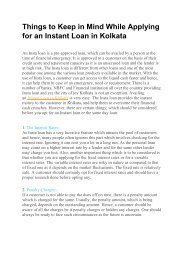Top 4 Thumb Rules of Perfect Cash Flow
The amount of money coming either by your salary, interest of your savings account or from your second income and the amount of money going out i.e. the money spent it may be normal your monthly expenses including the money spend on your luxuries, together constitute the cash flow Blog: https://financebuddha.com/blog/top-4-thumb-rules-of-perfect-cash-flow
The amount of money coming either by your salary, interest of your savings account or from your second income and the amount of money going out i.e. the money spent it may be normal your monthly expenses including the money spend on your luxuries, together constitute the cash flow
Blog: https://financebuddha.com/blog/top-4-thumb-rules-of-perfect-cash-flow
Create successful ePaper yourself
Turn your PDF publications into a flip-book with our unique Google optimized e-Paper software.
<strong>Top</strong> 4 <strong>Thumb</strong> <strong>Rules</strong> <strong>of</strong> <strong>Perfect</strong><br />
<strong>Cash</strong> <strong>Flow</strong><br />
The amount <strong>of</strong> money coming either by your salary, interest <strong>of</strong> your savings<br />
account or from your second income and the amount <strong>of</strong> money going out i.e. the<br />
money spent it may be normal your monthly expenses including the money<br />
spend on your luxuries, together constitute the cash flow. Maintaining a perfect<br />
cash flow can be understood in a better way by taking the example <strong>of</strong>- a water<br />
tank: In a water tank, water comes in at the top and goes (drains) out the bottom.
To keep the tank nice and full, one needs a balance between the coming water<br />
and the water drained. The same is with a perfect cash flow- to have a perfect<br />
cash flow there should be a balance between the money coming and money<br />
going out or you can say money spent.<br />
<strong>Cash</strong> inflow is the lifeblood <strong>of</strong> a business and for a family too, talking about a<br />
business it comes from sources like payments from customers, receipt <strong>of</strong> a loan,<br />
and monetary infusion from an investor. And when talking about a personal<br />
finance it comes from a person’s salary, savings account, and investment. <strong>Cash</strong><br />
(money) is the most important thing required to live because it later becomes<br />
payment for things which are essential to survive and for luxuries too.<br />
Naturally, a positive cash flow is always preferred.<br />
A positive cash flow basically means to have more incoming money than the<br />
money drained. A positive cash flow means your financial life is running<br />
smoothly as a positive cash flow is the perfect cash flow. A high positive cash<br />
flow is even better than a positive cash flow and it allows you to make<br />
investments as you have a plenty <strong>of</strong> incoming money which you can use to<br />
create even more money. Hiring more employees in your business, purchasing<br />
property, putting money in FDs etc. are some <strong>of</strong> the investments. This will pay<br />
you more, hence increasing your incoming cash.<br />
Getting a balance between your daily expenses, and a retirement fund and<br />
investment is very important to have a full financial plan, and here are some<br />
rules <strong>of</strong> thumb that can lead you to a right track to have a perfect cash flow.
Rule no. 1<br />
How Much to Save<br />
This is the first point and getting this right will lead to the basis <strong>of</strong> your positive<br />
household cash flows. Start by the calculation- income you get in hand and<br />
subtract a portion which you get by your savings.<br />
For a healthy financial life, one needs to save a minimum <strong>of</strong> 20% <strong>of</strong> his/her<br />
monthly income. However, one can definitely increase the percentage towards<br />
saving and making a 40% saving is really considered good from the take-home<br />
monthly income. But, this totally depends on your life-cycle and<br />
responsibilities. “If one has a number <strong>of</strong> responsibilities, the savings ratio will<br />
be lower. But generally, 20-40% is always a good range.<br />
Rule no. 2<br />
How Much to Invest<br />
Your calculation <strong>of</strong> how much to save can come with better results when<br />
invested in the right way. Invest your savings to make them grow so that it can<br />
provide you more returns. But it is very important to have the right amount <strong>of</strong><br />
investments that too at different places and asset classes to reach your financial<br />
goals. Asset allocation is important as it helps in diversifying and minimizing<br />
your risk and prevents a major setback if one <strong>of</strong> the assets witnesses a<br />
downturn.<br />
Physical assets<br />
Gold and real estate are the two physical assets on which generally people<br />
invest in India. But for better results, the physical asset should not be your only<br />
investment option. Investment in gold and real estate should not be more than<br />
one-third <strong>of</strong> your investment. And it doesn’t include the property in which you<br />
are living in.
Debt and equity<br />
The assets are needed to be spread across debt and equity very carefully.<br />
Always consider the risk factor before you invest. Using equity for the shortterm<br />
goals, as little risk might not be enough for the investment.<br />
Rule no. 3<br />
Savings towards Retirement<br />
One should always save a minimum <strong>of</strong> 10 percent <strong>of</strong> his/her income toward<br />
their retirement.<br />
The 10 percent rule gives people a target to work toward. Retirement savings is<br />
a must and it is the base <strong>of</strong> your future life. Saving 10 percent throughout your<br />
career would create a good amount <strong>of</strong> funds and it will be enough to provide a<br />
solid retirement nest for you and your partner.<br />
Rule no. 4<br />
How Much To Borrow<br />
As you are already done with expenses and savings. There are certain situations<br />
in life where you need to borrow. It may be to buy a home, gadgets or a car.<br />
You don’t have control over non-discretionary expenses, but what you can<br />
control is your discretionary expenditures like taking a holiday and buying a<br />
camera on EMI. However, a need for a loan cannot be avoided fully. But it’s<br />
important, to know the limit how much you borrow. Experts suggest that the<br />
total EMI on a person should not be more than 35% <strong>of</strong> the total take home<br />
salary.<br />
<strong>Cash</strong> flow is very important to maintain to have a balanced financial life. The<br />
above-mentioned points will surely help you to achieve a perfect cash flow in<br />
your life.


















